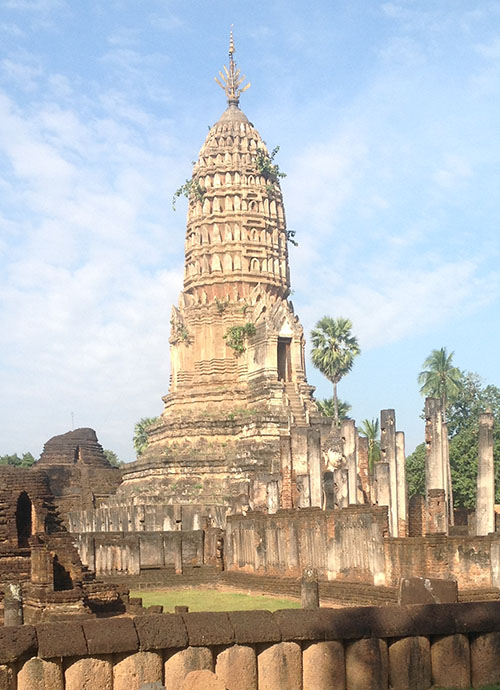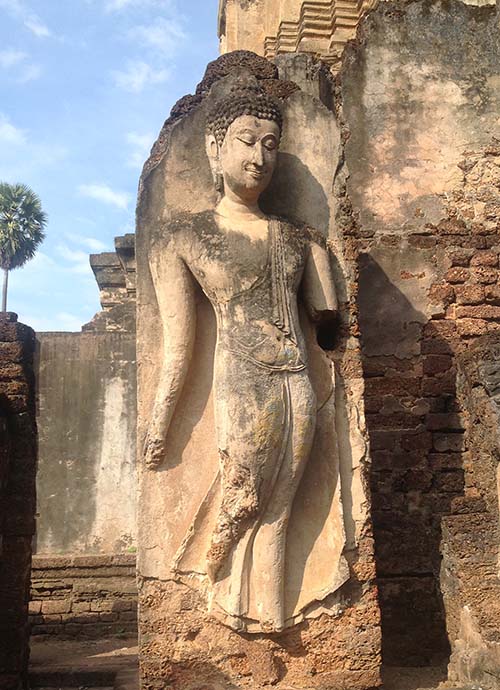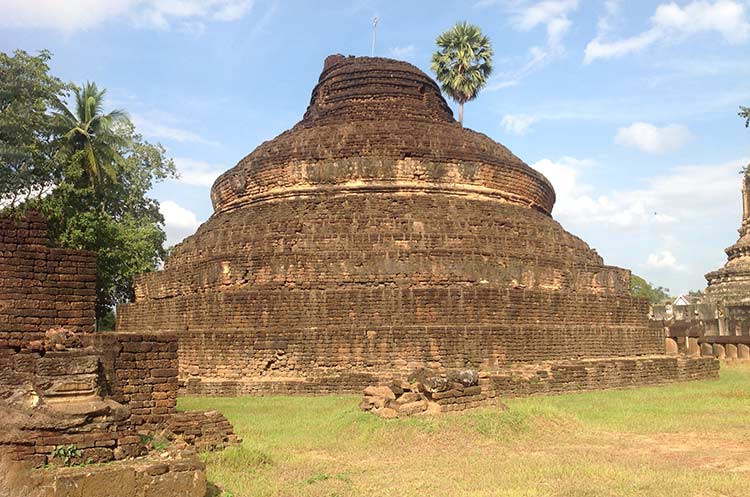
Wat Phra Si Rattana Mahathat
Wat Phra Si Rattana Mahathat Chaliang
Outside of Si Satchanalai’s town walls is the Wat Phra Si Rattana Mahathat, one of the oldest temples of Si Satchanalai Historical Park. The large temple is located East of the historic walled town in Chaliang, on a small peninsula almost entirely surrounded by the Yom river.
The Wat Phra Si Rattana Mahathat predates the Sukhothai era. It was founded in 1237, when the area was under control of the Khmer empire from Angkor. It was restored and expanded during the Sukhothai and Ayutthaya eras.
Today, the temple is an active monastery with a modern ubosot and kuti, the monks living quarters.
Khmer, Sukhothai & Ayutthaya styles
Surrounded by a wall of vertical laterite slabs topped with horizontal slabs is a large number of structures aligned on an East West axis.
The Wat Phra Si Rattana Mahathat houses structures from various eras and styles including Khmer (Bayon style pillar over the East entrance gate), Sukhothai (Phra Attharot standing Buddha image in the mondop, walking Buddha image in the principal viharn) and Ayutthaya (prang).
The temple area is divided in two sections separated by a laterite wall with a gate. The main structures of the East section are the prang and principal viharn, the West section contains the Phra That Mutao, a mandapa and a second viharn.
Pillar on the East entrance gate
The main entrance to the temple is a low gate on the East side of the enclosing wall. The gate is topped with a pillar that shows the temple’s Khmer origin. The well preserved sculptings of four faces remind of the face towers of the Bayon in Angkor, a temple built by King Jayavarman VII around the same time as the Wat Phra Si Rattana Mahathat. The four faces are believed to depict either the Bodhisattva Lokeshvara or Brahma, the Hindu God depicted with four heads. Below it are sculptings of Apsaras, female divine beings often found on the walls of Angkor temples.

Ayutthaya style prang
Main attraction of the Wat Phra Si Rattana Mahathat is a very well preserved corncob shaped prang. Built from blocks of laterite and covered with plaster, the prang dates to the second half of the 15th century, the early Ayutthaya period. It is believed to have been built over an older structure.
Originating from Khmer architecture, the style of the prang was adapted during the Ayutthaya period. A steep stairway leads to a cella about halfway up the prang that probably contained a linga, the representation of Shiva. The murals that adorned its interior have largely disappeared. Around the prang are several chedis in various states of preservation.
Viharn Luang Pho To
In front of the prang stands the Viharn Luang Pho To, the main viharn or assembly hall, of which today only the base and pillars remain. Seated on a pedestal in the back of the viharn is the large Sukhothai style principal Buddha image in the Bhumisparsha mudra of “Calling the Earth to witness”. The image is flanked by a stuccoed image of a graceful Sukhothai style walking Buddha, and another standing image, partly sunk into the floor.
Small viharn
Near the temple’s East entrance are the remains of another smaller viharn. An arched shrine contains an image of the Buddha seated on the coiled up body of a seven headed Naga snake, protected by the hood of the animal. The image depicts the story when the Buddha was meditating under the Bodhi tree when a violent storm broke out. A Naga snake appeared that sheltered the Buddha with its hood from torrential rain.
Phra That Mutao
Behind the prang, in the West section are the remains of a chedi named Phra That Mutao. The oldest structure of the temple, the Phra That Mutao is believed to be of Mon Dvaravati origin. Made from blocks of laterite, the chedi stands on a base of several receding octagonal tiers. On its East side is a steep stairway leading to a reliquary chamber. The structure’s top has collapsed. During excavation works parts of a golden spire were found that once topped the chedi.

Viharn Phra Song Phi Nong
Behind the Phra That Mutao are the remains of a viharn, an assembly hall named Viharn Phra Song Phi Nong. Its name translates to “viharn of the two brothers”, referring to the two large images inside.
To the back of the building are two large stuccoed images of the Buddha seated in front of each other on a pedestal, both in the “Calling the Earth to witness” or “subduing Mara” posture. Built from blocks of laterite over an older brick building, little more than the base and lower part of columns remain of the viharn today.
Mandapa
Near the Viharn Phra Song Phi Nong is a mandapa built of laterite blocks, covered with stucco. The mandapa enshrines a large standing image of the Buddha known as Phra Attharot.
Phra Attharot images were popular during the Sukhothai era. A very similar mandapa enshrining a Phra Attharot image can be found at the Wat Mahathat in Sukhothai Historical Park. Some archeologists believe that the mandapa originally enshrined Buddha images in four different postures, each facing a different direction, similar to those of the Wat Chetuphon and Wat Phra Phai Luang in Sukhothai Historical Park.
Ubosot, the ordination hall
Outside the walled area, East of the prang stands the temple’s ubosot, a modern structure built over the remains of an older one. Inside the ordination hall which is still in use today is a large golden Buddha image in the “Calling the Earth to witness” posture. In front of it is a number of smaller images in various postures.
- Wat Chang Lom
- Wat Chedi Chet Thaeo
- Wat Nang Phaya
- Wat Khao Phanom Phloeng
- Wat Chom Chuen
- Wat Chao Chan